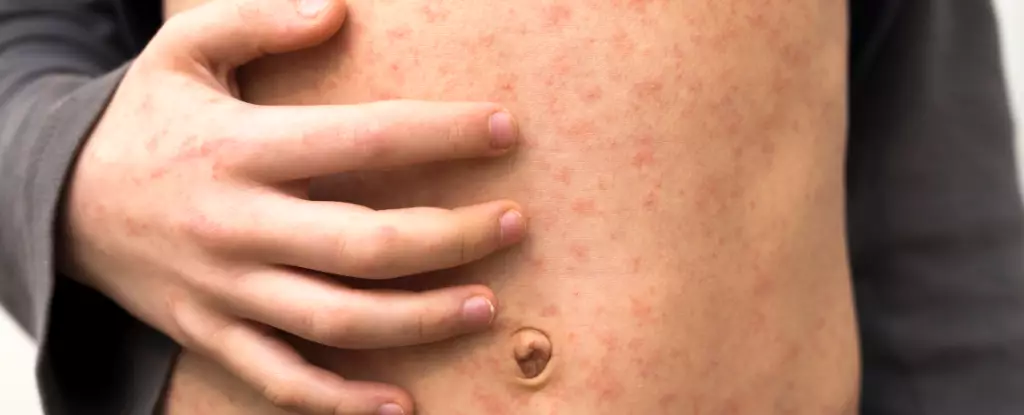As of March 28, 2025, America is grappling with a resurgence of a ruthless disease that many have dismissed as a relic of the past—measles. The outbreak’s epicenter is Texas, where confirmed cases now exceed 400, with New Mexico and Oklahoma reporting over 50 cases combined. Alarmingly, public health officials suspect that these figures may be drastically underestimated. The implications are clear: this is not merely a localized issue but a potential national health crisis. In the wake of this outbreak, we must confront a disconcerting reality: complacency can breed disaster.
The Spread of Infection
In our globally interconnected world, the measles virus has demonstrated a capacity to spread efficiency that is nothing short of alarming. Reports have surfaced linking potential exposures to crowded public spaces, including major transit hubs like Washington Dulles International Airport and Amtrak trains. Such examples underscore how easily this virus can leap from one individual to another, particularly among the unvaccinated. Measles is not merely another childhood illness; it is one of the most contagious pathogens known, with an alarming 90% infection rate among unvaccinated populations.
Given the statistics surrounding hospitalization, the threat becomes even more stark. While 14% of infected individuals required hospitalization in 2025, the previous year saw that figure rocketing to 40%. This situates measles as not just an inconvenience but as a harbinger of severe health complications, showcasing the potential for devastating consequences should vaccination rates continue to wane.
Understanding the Impact
Contrary to the outdated notion of measles as a harmless childhood disease, the reality is far more dire. Measles is capable of inflicting significant damage on the lungs and immune system. Individuals who contract the virus may face severe respiratory issues, often culminating in viral pneumonia. The risk is particularly acute in children, with statistics indicating that approximately 1 in 20 infected children will develop pneumonia, which tragically stands as the leading cause of measles-related mortality in the pediatric population.
Furthermore, the virus does not solely confine its damage to the physicality of the lungs; it infiltrates the nervous system, either directly causing brain damage in approximately 1 in 1,000 cases or indirectly via post-infection inflammation. The long-term consequences can be harrowing, leading to life-altering impairments, such as blindness and deafness. This reality starkly contrasts the normalization of measles as a benign childhood ailment.
The Deterioration of Immunity
An area that should raise significant alarm is the ability of the measles virus to undermine the immune system’s robustness against future infections. Research has long hinted that children who receive the measles vaccine exhibit enhanced overall immunity, yet the underlying mechanisms remain elusive. Astonishingly, measles infection can erase the immune system’s memory, weakening its capability to protect against previously encountered pathogens. This means that a single measles infection could lead to increased susceptibility to a variety of diseases, compounding public health risks far beyond the immediate threat of measles itself.
Investigation into the late complications of measles infection reveals frightening outcomes such as subacute sclerosing panencephalitis (SSPE)—a progressive and invariably fatal form of dementia that can surface years after recovery from measles. While SSPE is rare, occurring in about 1 in 25,000 cases, its probability skyrockets in infants infected before their first birthday, underscoring the insidious nature of this virus.
Prevention: The Most Effective Strategy
Despite the ongoing research into potential treatments for measles, including emerging antibody therapies, vaccination remains unequivocally the most effective and proactive approach to thwarting this disease. The MMR (measles, mumps, rubella) vaccine boasts an impressive efficacy rate of 97% after two doses. With such a powerful tool at our disposal, the responsibility lies not just with individuals but with society as a whole to champion vaccination efforts and to educate parents about the immense risks posed by the disease.
Inertia can lead to catastrophe. Our collective health hinges on continued vigilance against diseases like measles, particularly when misinformation can easily proliferate within communities. Ignoring this reality is tantamount to inviting danger into our lives. The time for complacency is over; the time for action is now. The unyielding virus reminds us that the age of vaccination is not merely a chapter in our health history but an ongoing battle that requires our unwavering commitment and engagement.


Leave a Reply